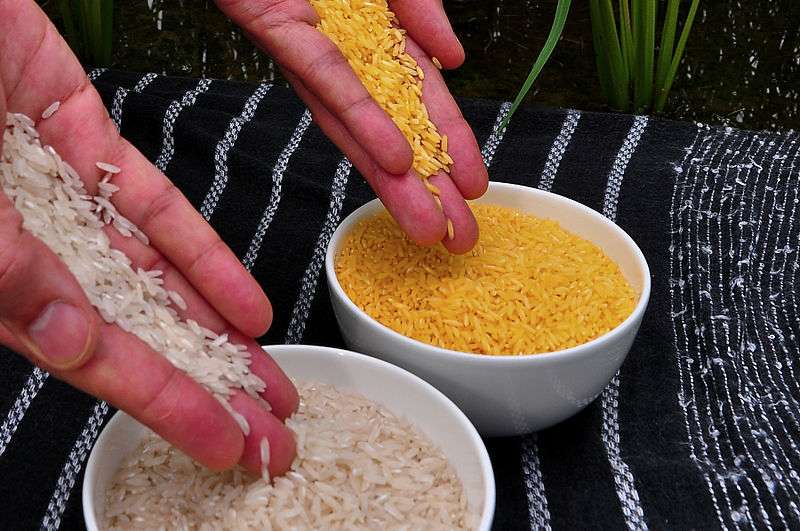Modifications, Main Crops & Environmental Effects
\\Some sort of intro paragraph or blurb to this page before going into each sub-topic...something that presents some interesting, relevant information that will flow well into the sub-topics to separate header 1 from the header 2\\
Modifications
When it comes to genetic engineering of foods, there are different intended results by the modification. Some crops, like rice, are modified to create a potential health benefit for its consumers (especially in developing countries). Vitamin A is often added to the rice, creating vitamin-rich "Golden Rice," which adds vitamin A into the diet of populations that consume rice.

The most common types of genetic modifications in the United States strive to improve the quantity and quality of agricultural production. These modifications are the most frequent and significant. These common and controversial modifications target a crop's tolerance to herbicides and generate pest resistance or a repellant.
\\ I think the "Modifications" section could use more elaboration. For example, there is more that can be said about the whole "quantity and quality" purposes regarding resistance to pesticides. Also there can be more examples of potential benefitsin addition to the Golden Rice//
| Click below the question to view the answer. | ||
Main Crops
The interactive chart below illustrates the distribution of GMO crops around the world, the quantity of land (in hectares) that is allocated for these crops in each country, and the primary crops that are grown there. This chart is useful to help us visualize the difference in prevalence of GMO crops among certain countries. The United States clearly has the most GMOs worldwide, but what's more interesting is the prevalence throughout the rest of the Americas.
![]()
![]()
via chartsbin.com
Enviromental Effects
The issue of GMOs is a polarizing one. Those who are pro-GMO claim that GMOs are not only safe for us and the environment, but also potentially, a very beneficial development. Those who are anti-GMO argue that the risk of negative consequences to our environment is high and very difficult to predict. It is important to determine the magnitude of potential damage to our environment due to the spread of GMO genes into wild plants and microbes. GM crops can cause short and long term effects on the environment.
Different kinds of modifications are being bred into crops. The most common kinds of modification include: pesticide resistance, disease resistance, and drought tolerance. Other, more superficial, changes can be made to crops we encounter regularly.
Some Potential Consequences to the Environment Include:
- Unintended selection
- Unwanted change in gene expression
- Unintended effect on non GM weeds, pests, or pathogens
- Survival & persistence beyond intended zone
- Production of toxic substance to 'non-target' organisms
- "Horizontal Gene transfer "
\\ To make the section below seem less dense, need to present it differently...i.e. via interactivity \\
Scientists have bred pesticide resistance into these crops, which causes controversy when pesticides, such as Roundup, are over sprayed. By using such quantities of chemicals to control weeds in the crops, the weeds begin to develop their own resistance to the pesticides thus creating 'super weeds.' This phenomenon is referred to as gene transfer. Seed dispersal and pollen transfer caused by wind, animals, and farming equipment, contribute to gene transfer.
There are many studies that examine the potential environmental and ecological risks of GMOs. L.L. Wofenbarger and P. R. Phifer discuss some of the existing studies and literature regarding these potential risks. These studies suggest that there is a heightened risk for hybridization among GMO crops. This undermines any control scientists have over GMO crops and leads to the evolution of weed species that carry the genetic modification (like pesticide resistance). When the weeds obtain pesticide resistant DNA from GMO crops, this defeats the purpose of modifying the crops at all.
among GMO crops. This undermines any control scientists have over GMO crops and leads to the evolution of weed species that carry the genetic modification (like pesticide resistance). When the weeds obtain pesticide resistant DNA from GMO crops, this defeats the purpose of modifying the crops at all.
While there is some widely accepted evidence for these negative impacts against the environment and a lack of evidence proving otherwise—there are compelling statistics concerning potential benefits to the environment.
- A decreased use of pesticides & insecticides
- Reduced greenhouse gas emissions
Evidence has shown that with the introduction of GMO crops, there has been a significant decrease in the use of pesticides and insecticides. Brookes and Barfoot note a global trend toward reducing greenhouse gas emissions since GMO use has increased. They explain that pest-resistance and repellant traits that are bred into the crop's DNA lead to a reduced necessity for the use of pesticides and insecticides. This global decrease in the amount and frequency of pesticide use means fewer instances of pesticide spraying reduces the use of fuel and consequently reduced greenhouse gas emissions.
For such a complicated topic, one thing remains clear: the use of GMOs and the effects they have (either positive or negative impacts) on the environment must be effectively measured so that we might isolate trends and be able to find a clearer answer about whether or not GMOs are hurting or helping our environment.

